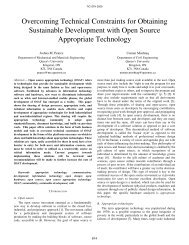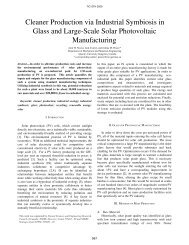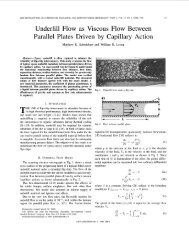Optimizing greenhouse gas mitigation strategies to suppress energy
Optimizing greenhouse gas mitigation strategies to suppress energy
Optimizing greenhouse gas mitigation strategies to suppress energy
You also want an ePaper? Increase the reach of your titles
YUMPU automatically turns print PDFs into web optimized ePapers that Google loves.
2nd Climate Change Technology Conference<br />
2ième Conférence sur les technologies du changement climatique<br />
May 12-15 mai 2009, Hamil<strong>to</strong>n, Ontario, Canada<br />
derivation transparent, it is assumed that the additional capacity does not produce (or<br />
conserve) its <strong>energy</strong>, rC T t, in that year but only in subsequent years. The time that the GHG<br />
emission reduction technology takes <strong>to</strong> pay for itself in terms of <strong>energy</strong> it needs over its life<br />
cycle, or the t EP , is given by embodied <strong>energy</strong> invested (over the entire life cycle), E E , divided<br />
by <strong>energy</strong> produced (or <strong>energy</strong> saved), E P/S . Thus t EP , as measured in years, is:<br />
t EP<br />
= E E<br />
E P/S (2)<br />
An identical analysis can be completed for GHG emissions. If a given ET causes GHG<br />
emissions during its manufacture and use, it must operate for a finite amount of time <strong>to</strong><br />
achieve climate forcing neutrality.<br />
2.2 Energy cannibalism<br />
The <strong>energy</strong> needed for the growth of the entire ET ensemble is given by the cannibalistic<br />
<strong>energy</strong>, E Can :<br />
E Can<br />
= E E<br />
E P/S<br />
rC T<br />
t (3)<br />
Regardless if the technology is an <strong>energy</strong> producer or conserver, the technology ensemble<br />
will not produce any net <strong>energy</strong> if the cannibalistic <strong>energy</strong> is equivalent <strong>to</strong> the <strong>to</strong>tal <strong>energy</strong><br />
produced. So by setting equation (1) equal <strong>to</strong> (3) and simplifies <strong>to</strong> set equation (2) equal <strong>to</strong> the<br />
inverse of the growth rate:<br />
E E<br />
E P/S<br />
= 1 r = t EP (4)<br />
Equation 4 shows that the growth rate of an ET industry may not exceed the reciprocal of the<br />
<strong>energy</strong> payback time <strong>to</strong> have a positive net <strong>energy</strong>. For example, if the <strong>energy</strong> payback time is<br />
4 years and the capacity growth of either an ET ensemble is 25%, no net <strong>energy</strong> is produced<br />
and no GHG emissions are offset. This is because the same analysis is also true for GHG<br />
emissions. The embodied GHG emitted in order <strong>to</strong> provide for the ET divided by the<br />
emissions offset every year must be equal <strong>to</strong> one over the growth rate of the ET simply <strong>to</strong><br />
break even. This cannibalism of <strong>energy</strong> for new ETs has a profound effect on their ability <strong>to</strong><br />
assist in the <strong>mitigation</strong> of GHG emissions.<br />
It should also be noted here that the <strong>energy</strong> payback times for a given ET are dependent on<br />
the exact deployment. For example, a wind genera<strong>to</strong>r will have a much faster t EP and thus<br />
allow for a higher growth rate if deployed in a region with high average wind speeds, while<br />
the same genera<strong>to</strong>r deployed in a less attractive location will have a lower t EP . Similarly, a<br />
high efficiency solid-state lighting system will have a faster payback if it is installed in a<br />
location that demands constant use (e.g. an enclosed stairway or in emergency exit signs)<br />
Page 3 of 9








